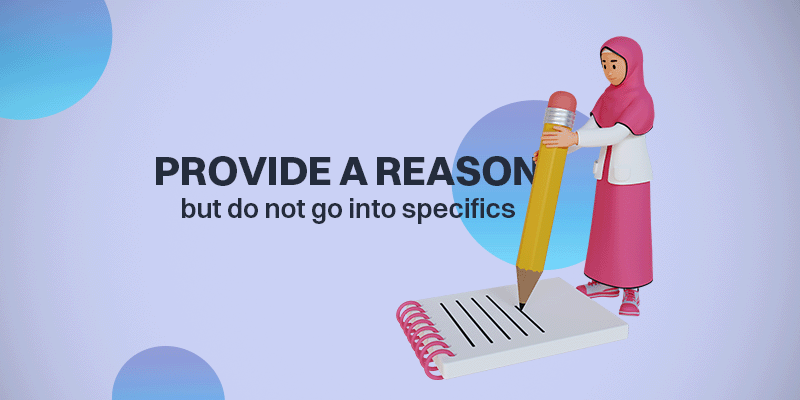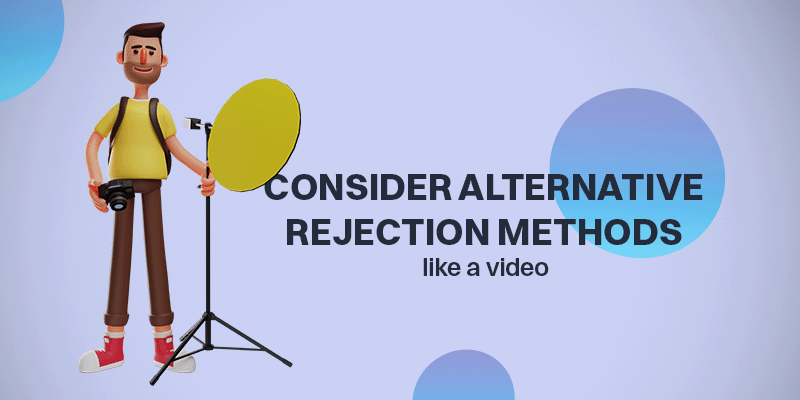How to Craft Perfect Candidate Rejection Message
A few years ago, a candidate rejection message from a Cleveland businesswoman went viral, and all for the wrong reasons. The devastating rejection letter was leaked online, which provoked a massive backlash. Which lead to the inevitable apology. Although, it still damaged the company’s reputation.
It provides a great template of how not to reject a candidate. But the fact is that rejection letters are hard to write well, and not writing one at all can be just as bad. So how do you provide feedback with respect and honesty without crushing people’s dreams and hurting your business reputation? In this post, we’ll give you all the tips and tricks needed to handle candidate rejections as seamlessly, professional, and happily as possible.

#1 Never Forget to Reply
It’s the golden rule that so many companies get wrong. Most people can probably nod yes to the fact that they’ve been ghosted by a company after spending loads of time on a “perfect” application.
We get it: hiring managers don’t have an infinite amount of time or resources. But, consider the following statistics from Workable:
- 75% of candidates never hear back from a company after sending an application.
- 42% of candidates will not reapply for a position again if they’re not replied to.
- 22% will tell others not to apply to the company and even go as far as boycotting their products.
What this tells us is that failing to provide feedback isn’t saving you time: it’s damaging the company’s reputation and brand perception.
Imagine 22 candidates out of 100 that you rejected went on to hammer your employer brand to their network of friends and family. Now you got a lot more than 22 people boycotting your company just because you didn’t reply to a candidate. And we all remember the power of word of mouth, right?
According to Nielsen Insights, 92% of people trust recommendations from family and friends over any other type of advertising. Candidates are reasonable. They don’t expect a personal call if they’ve only emailed their CV. But any answer is better than none. The proportion of time spent on each rejection letter or call should be proportional to how close the candidate is to the job…
If you’re running a startup, it is imperative to reply to all your candidates because you can’t afford a bad reputation when you have not established your brand yet. It simply is a bad equation for growth. More and more recruiting software is also starting to feature automatic replies. This should make it easier for your time management.
You can also read The 5 Gate-Opening Keys to Branding Your Startup.
#2 Increase Personalization at Each Applicant Stage
Every application process comes in a few stages. There’s the first touchpoint, where the candidate finds the post. The initial submission. Maybe a few emails of back and forth. Eventually an interview. And if you consider the candidate’s experience, it’s easy to see each stage is a kind of progression towards their dream goal: to work at your company.
The closer they get rejected, the greater the disappointment. So, your goal, in essence, is to manage expectations and potential disappointment. It’s a game of balance.
If the candidate only submitted their application through a job portal, an automated email will suffice. But for someone who made it to the final stages of an interview, you’ll need to consider at least a phone call, personal email or video response.
Essentially, the more time the candidate spent on their application, the more time you should spend on their rejection answer. By doing this you are showing respect by matching the effort someone else put in to impress you. Why not return the favour? I mean you asked for the application right?

#3 Provide a Reason (But Don’t Go into Specifics)
“Dear candidate, we thank you for your application, but you didn’t get the job.” Not so friendly or helpful is it? You’ll need to put a bit more effort into your rejection communications.
For instance:
- The candidate isn’t qualified enough: explain how you’d love to hear from them again once they’ve gained a bit more experience. You could even mention learning courses and links to other job opportunities.
- The candidate is overqualified: this one is harder to handle, but you can explain that you were impressed by their skills. Still, the job went to someone else, and you will keep them in mind if a position better suited to their abilities opens in the future.
- The job isn’t available at all: this can happen, especially in a fast-paced startup environment. The skills you thought were needed are simply not in demand anymore because you’ve shifted to a new product or business focus.
But there’s a big caveat here: be careful in your wording and avoid specifics. This could come back to haunt you with legal repercussions such as unlawful discrimination. Regarding discrimination, we also wrote a content piece on how to improve your posts in diversity and inclusion.
#4 Be Respectful and Honest
Honesty is the best policy, whether it comes to job posts or rejection letters. There are two core reasons, the first is that it’s a mark of respect for the candidate. Don’t forget to say thank you.
Secondly, you’re also protecting yourself legally. You want to avoid empty promises, which could be misinterpreted as legally binding. If you don’t plan on keeping their CV on file, don’t say you will in the rejection letter. This could end up badly for you if you’re in a particularly litigious market like the U.S.
Common sense and professionalism are key, which is something we’ll trust you’re excellent at if you’re still reading this post!

#5 Consider Alternative Rejection Methods Like Video
We’ve focused a lot on letters and emails so far, but phone calls and even video recordings are a great way to provide feedback, especially if you’re rejecting a candidate in the later stages of the application. It brings a personalized aspect to the rejection and will make the delivery a bit easier for both parts. Rejecting candidates through video is time-consuming, so this is most suitable for the later stages when you’re down to only a few candidates.
A video message, for instance, ticks a lot of boxes: you can control the tone of the communication, add personalization touches, and ensure the candidate’s hopes aren’t crushed by a faceless organization.
Just make sure you’ve got your rejection template ready in advance, and that it sounds natural, not like a forced apology.
This is how you go about a video rejection message:
- Say thank you! Always make sure you say the candidate’s name and thank them for wanting to apply to your company and participating in the recruitment process. But try to say it naturally and affectionately. You don’t want to sound like the standard email rejection everyone gets, because then you’re wasting time making a video. Remember to individualize your approach to each candidate.
- Deliver the bad news. But don’t forget to explain. You have to deliver the message to the candidate that the person did not get the job and it is never pleasant. This is why it is important to explain why they didn’t get the opportunity and provide constructive feedback so they are aware of what they need to improve. According to LinkedIn Talent Solutions, a candidate is 4 times more likely to consider applying to your company again in the future when you provide constructive feedback.
- Round it up and let’s keep in touch. The late stages of recruitment are the hardest ones because you reject a lot of really talented candidates. That’s why it is important to motivate them to stay in touch with you and the company for future opportunities. If you want to go above and beyond, you offer them the opportunity to ask you questions or maybe connect with you on LinkedIn. That’s a nice way of still showing interest in them as professionals and also a way to make sure you receive good applicants the next time you recruit.

Templates: Two Examples of Great Rejection Message
Remember how we mentioned increasing the amount of effort you put into your rejection messages? We thought we’d illustrate it with two different templates at both ends of the candidate journey.
The Short and Sweet Rejection Letter
If your candidate has only applied via, say, the Hub, they’re probably filled out a form and submitted a CV. It’s a process they could easily automate, and your rejection letters at this stage can take a similar cookie-cutter approach.
Hi [first name],
Thank you for your interest in the [role] at [company name].
We ended up moving forward with another candidate, but we appreciate that you invested time and effort in this application.
Wishing you the best of luck with your job search and future professional endeavours.
Best,
[sender name]
The Personalized Letter with Feedback
In the following scenario, our candidate has progressed through many application stages, and even met face-to-face with you, the recruiter. Still, someone else got the job because they were a better fit. Here’s what you could say.
Hi [first name],
I wanted to personally thank you for taking the time to come meet us at [company HQ].
Unfortunately, after much consideration, we decided to move forward with another candidate.
While we were impressed with your experience and enthusiasm, especially in answering [specific interview question], we won’t be able to offer you the position at this stage. However, we will keep your resume on file and will get in touch with similar positions if they do become available.
Moreover, if you are interested in gaining more experience in the field, I am happy to forward your contact to [training company], which specializes in providing training in [job position] which could improve your chances in the future.
On behalf of [company], I’d like to thank you once again and wish you all the best with your professional career.
Sincerely,
[sendername]
Key Takeaways
Rejection communications aren’t fun to deal with, but they’re also an essential part of the hiring experience. Failing to notify candidates at the right time, and with the right level of personalization could leave them frustrated and dissatisfied with your company.
This, in turn, could hurt your brand reputation, shrink your talent pool, and even potentially damage your business.
Hopefully, thanks to the tips in this article, you’ll have good pointers on how to craft perfect rejection messages that can save you time and effort, and even bring a smile to candidates’ faces.
Did you already hire your team? Have you considered offering equity instead of huge salaries?. We wrote a popular 101 startup equity guide that you could also benefit from!
